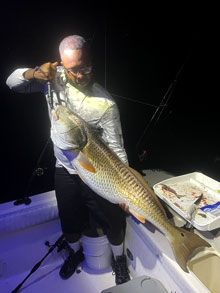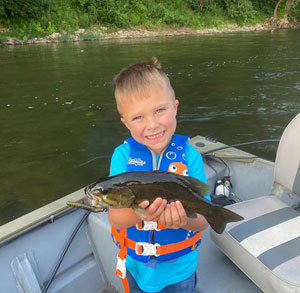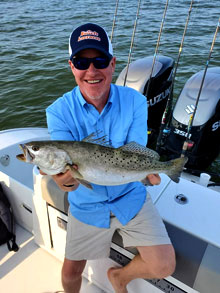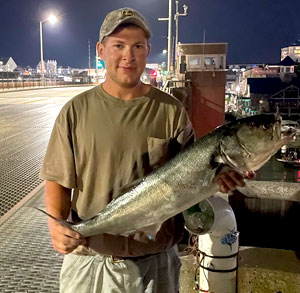Maryland Fishing Report – July 21

Ethan Zlokovitz caught this channel catfish from shore on a menhaden chunk near the mouth of the Magothy River.
With the striped bass fishery currently closed, anglers are targeting alternate species such as catfish, perch, spotted sea trout, red drum, bluefish, cobia, and Spanish mackerel.
Anglers are reminded that the striped bass fishery is closed in the Chesapeake Bay until August 1 to lessen catch-and-release mortalities of undersized striped bass. Throughout the summer be sure to also check the striped bass fishing advisory forecast to help protect this iconic species during harsh conditions.
Forecast Summary: July 21 – July 27:
Bay conditions will be similar to last week’s conditions. Sunny, very warm weather forecasted this week should continue to keep water temperatures high. Long-term Maryland DNR water monitoring shows peak Bay temperatures typically occur in mid to late July. Bay surface water, river, and steam temperatures are in the mid 80s and will continue to rise this week. July monitoring data is showing main Bay bottom waters are still slightly cooler than surface waters, and continue to show poor oxygen conditions. As a result, Bay gamefish will likely be higher in the water column to find adequate oxygen and their preferred water temperatures. The coolest oxygenated bottom waters can be found from the Kent Island area north to Tolchester. Due to evening Conowingo dam releases, cool water is also present on the Susquehanna River through the Susquehanna Flats area in the late evening and early morning. Bay surface temperatures cool by 2 to 3 degrees at night.
Due to low bottom oxygen levels, avoid fishing below the following depths in these locations: Susquehanna Flats to Still Pond, adequate oxygen to bottom; Swan Point, 25 feet, Bay Bridge to Bloody Point, 5 feet to 25 feet; Choptank River to Point No Point, 15 feet to 35 feet. On the Potomac River from Colonial Beach to Piney Point, avoid fishing deeper than 5 feet to 35 feet. Conditions can vary daily so be sure to check the depth-to-oxygen level online prior to your next fishing trip.
Maryland upper Bay waters down to the Bay Bridge are running saltier than normal while the waters south of the bridge are normal. Except for the higher than normal flows in the Susquehanna River, expect average flows for most Maryland rivers and streams. There may be localized high flows from the forecasted thunderstorms on Wednesday and next Monday. There will be above average tidal currents all week as a result of the upcoming full moon on Sunday, July 25.
Expect average clarity for Maryland portions of the Bay and rivers, but expect very poor water clarity due to algal blooms in the North East, upper Bush, Back, and middle Patuxent Rivers. Reduced water clarity may be present in some areas due to possible thunderstorms causing high flows on Wednesday and Monday. To see the latest water clarity conditions on NOAA satellite maps, check Eyes on the Bay Satellite Maps.
As always, best fishing areas could be further refined by intersecting them with underwater points, hard bottom, drop-offs, and large schools of baitfish. For more detailed and up-to-date fishing conditions in your area of the Bay, be sure to check out Eyes on the Bay’s Click Before You Cast. Get updates on Maryland’s waters sent to your inbox with our Eyes on the Bay newsletter. Sign up online.
During the summer, the Conowingo Dam releases large amounts of water during the afternoon hours for power generation, and shuts down during the early morning hours. At the time of this writing, flows have been relatively high, in the range of 60,000 cubic feet per second, and the dam crews are preparing for spill conditions with one to five gates expected to be open during the next few days. For more information on spill conditions, please call the Conowingo spill hotline at 1-877-457-2525. Blue and flathead catfish have been common in the dam tailrace area.

Jim Summers caught this blue catfish just below Conowingo dam. It was caught on a small spinner and nightcrawler. Photo courtesy of Jim Summers.
Blue catfish and channel catfish in the upper Bay should provide steady action through the striped bass closure. Anchoring up or drifting with cut baits are good ways to fish for them, as is casting from shore. Fresh-cut menhaden or gizzard shad make the best baits, but frozen menhaden, sea herring, chicken liver, nightcrawlers ,and clam snouts can work well on a simple one-hook bottom rig. Using a fish finder rig can work well for finicky catfish since they do not feel the weight of the sinker when picking up the bait. Fishing for white perch can offer plenty of fun for those fishing light tackle in the tidal rivers and creeks of the upper Bay. Small lures such as beetle spins, spinners, small jigs, and twister tails are good choices to fish shoreline structure in the early morning and late evening hours. White perch have also moved out into the Bay and are holding on oyster knolls and shoals. Fishing with a bottom rig baited with pieces of bloodworm, grass shrimp, or Fishbites is productive. Use the lightest possible sinker to hold bottom. Around 1 ounce works well enough if currents are slow.
White perch will be offering light tackle action for anglers during and after the striped bass closure. The perch are available in the tidal rivers and creeks when casting small lures in the early morning and evening hours. Shoreline structure such as submerged rocks, rip-rap, old breakwaters, and points are all good areas to cast beetle spins, small spinners, and jigs. Many deeper shoreline areas near piers can offer fun white perch fishing by using simple bottom rigs baited with grass shrimp or pieces of bloodworm. Small jig heads tipped with grass shrimp or bloodworm also work well. Perch may be found holding close to dock piers and pilings and under the docks.
Spotted sea trout, also known as speckled trout, are being found around the mouth of the Choptank and as far north as Eastern Bay. Paddletails on 1/8 ounce – 3/16 ounce jig heads are a popular lure and they can also be caught on soft crab or peeler crab. Anglers have been reporting that some of the sea trout have moved out to slightly deeper water off the shoreline during the recent heat wave.
Cobia are still being reported in the lower Bay. Chumming and drifting live eels or live spot back in the chum slick is a proven method to catch one of these great gamefish, which were known as “crab-eaters” and “black bonito” in the Bay many years ago. Some anglers have also reported success with live eels bounced on the bottom with a sinker rig. Trolling surgical tubes or hoses is also productive. Sight fishing with an elevated platform has become an increasingly popular fishing method in recent years. After spotting a cobia, casting a live eel, large soft plastic, or large bucktail is a good way to target them. Smith Point, the Middle Grounds, the Target Ship, and Virginia waters are good places to find cobia.

Tyrik Williams caught and released this big red drum near Point Lookout while fishing with cut bait for bluefish. Photo by Adrian Dandridge.
Some exciting news for red drum anglers: puppy drum are in the shallows up to Chesapeake Beach and the mouth of the Choptank River. Small paddletails work great for these fish. The big bull redfish are beginning to show up in southern Maryland waters.
Spanish mackerel are beginning to show up in the lower Bay and we hope that they continue to move north. The best way to target Spanish mackerel is by trolling small Drone and Clark spoons behind inline weights and planers at a speed of 6-8 knots. Casting and retrieving small metal lures at high speeds around breaking Spanish mackerel is another effective technique. Bluefish are working their way up the Bay and have been found up to Breezy Point and the mouth of the Choptank River.
The Cedar Point rocks, bulkhead areas, the cuts through Hoopers Island, and the marsh edges of the lower Eastern Shore are all good places to fish for spotted sea trout. Another spot that has been good in recent years is casting around the foundation structure of Sharp’s Island lighthouse. Some speckled trout have been found as far north as Eastern Bay.
Bottom fishing in the lower Patuxent River, Solomons Island, Tangier Sound, and St. Mary’s River should be steady for the next few weeks. Some flounder are being caught in the Tangier and Pocomoke sounds along channel edges and adjacent hard shoals. Croaker have been rare with only a few small ones reported, mainly in Virginia waters.
Finally, a reminder that the main stem of the Potomac River will remain closed to striped bass fishing through August 20. The tidal rivers on the Maryland side of the river are closed until August 1.
Recreational crabbing has been tough for most crabbers this year, with some large ones being caught in the upper Bay up to 9 inches in size. Recreational crabbers can catch anywhere from a couple dozen good crabs up to a half bushel. Generally, catch in the lower Bay has been lagging behind the middle and upper Bay regions. Some good catches have been reported between Deale and the West/Rhode river area. In recent years, most savvy crabbers find using razor clams will produce better catches, while others rely on the old standby of chicken necks.
This week’s freshwater fishing report was provided by inland fisheries biologist and resident muskie expert Josh Hennesey.

Bennett Henesy enjoying an excellent summer evening on the freshwater Potomac with a nice smallmouth bass. Photo by Josh Henesy.
The upper Potomac River continues to run low and clear. Water temperatures have well exceeded 80 degrees, with some sections above 85 degrees. These increased temperatures have caused the recent nuisance algae (cyanobacteria) bloom to all but vanish throughout the river.
Smallmouth bass fishing has been the talk of the river lately as many anglers are experiencing excellent fishing outings! Fish measuring 8-12 inches have been most common, with decent numbers of larger fish intermixed. Anglers find success by targeting large boulders, ledges, vegetation, and woody debris in areas of moderate to considerable current. Fish tend to hold in slightly deeper pockets of water situated within the otherwise shallow river. Lure selection has varied from smaller light-rigged soft plastics to top water, especially during early mornings and late evenings. Biologists suspect that good growth rates from the 2019 and 2020 year classes are largely contributing to the current population. Researchers will collect age data later this year to confirm these assumptions.
Other river anglers have been taking advantage of an increasingly popular catfish fishery. Both channel and flathead catfish species are found in high abundances and have been providing recreational opportunities throughout the river. These species tend to seek out deeper water during daylight hours with abundant woody debris. At night, which is the most common time for angling, larger fish move into the shallows to feed. Channel catfish can be caught on a variety of bait types, while flatheads tend to be more selective and finicky.
Recent reports from the Atlantic coast indicated some slow improvement of water clarity in the surf. Anglers are kingfish, small croaker, and spot on pieces of bloodworm or Fishbites. Those fishing with cut spot strips are catching small bluefish and flounder.
At the inlet and back bays, there have been decent numbers of mainly sub-legal striped bass. Most are working white soft plastic jigs or bucktails dressed with a curly tail, and the “Roy Rig” lure near the South Jetty and near the Route 50 Bridge. Small and medium-sized bluefish are running in and out of the inlet and back bay areas, and at least one large one was caught at the Route 50 Bridge.
In the back bay areas, the summer fishing focus continues to be on flounder. They are being found in the channel areas of Assawoman and Sinepuxent bays. Drifting with traditional baits of squid strips or minnows is popular, and working large soft plastic jigs in white or pink work well for the larger flounder.
The wreck and reef sites continue to provide excellent fishing for black sea bass. Limits are not uncommon and there is plenty of action for novice anglers and visiting tourists from all over the country. Flounder have also been caught around the artificial reef and wreck sites around the edges of the structure.
There have been a few reports of the elusive bluefin tuna on the inshore lumps, but most of the offshore action has been with yellowfin tuna. Most recent reports indicated success with trolling for yellowfin tuna at the Washington canyon. Anglers also reported that several hooked yellowfin tuna were bitten off by hammerhead sharks. Trolling the canyons is producing a mix of yellowfin tuna, dolphin, and the occasional white marlin. One 500 pound blue marlin was caught and released!
Lastly, the Department of Natural Resources reminds offshore anglers that a catch card must be completed and exchanged for a tag to land bluefin tuna, swordfish, billfishes, or sharks in Maryland. Details and forms for the Catch Card Census are available on the DNR website.
“Do not tell fish stories where the people know you. Particularly, don’t tell them where they know the fish.” – Mark Twain
This week’s Maryland Fishing Report is written and compiled by Erik Zlokovitz, Maryland Department of Natural Resources recreational fisheries specialist.
Click Before You Cast is written by Tidewater Ecosystem Assessment Director Tom Parham.
This report is now available on your Amazon Echo device — just ask Alexa to “open Maryland Fishing Report.”




 1-888-373-7888
1-888-373-7888 233733
233733